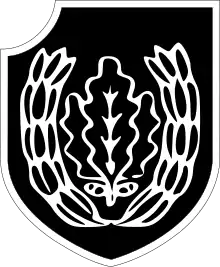16th SS Panzergrenadier Division Reichsführer-SS
The 16th SS Panzergrenadier Division "Reichsführer-SS" (German: 16. SS-Panzergrenadier-Division "Reichsführer SS")[1] was a motorised formation in the Waffen-SS of Nazi Germany during World War II.
| 16th SS Panzergrenadier Division Reichsführer-SS | |
|---|---|
 Unit insignia | |
| Active | 1943–45 |
| Country | |
| Branch | |
| Type | Panzergrenadier |
| Size | Division |
| Patron | |
The division, during its time in Italy, committed a number of war crimes, and, together with the 1st Fallschirm-Panzer Division Hermann Göring, was dis-proportionally involved in massacres of the civilian population.[2] One possible reason for the division's increased involvement in war crimes has been identified in the fact that much of its leadership originally came from the SS-Totenkopfverbände.[3]
History

Formed in November 1943 when Volksdeutsche recruits were added to the Sturmbrigade Reichsführer SS, which was used as the cadre in the formation of the new division. A Kampfgruppe ("combat group") from the division fought at the Anzio beachhead, while the rest of the division took part in the occupation of Hungary. It fought in Italy as a division from May 1944, until being transferred to Hungary in February 1945.
On June 27, 1944, the 16th SS-Panzergrenadiers command post in San Vincenzo, Italy was overrun by the U.S. 1st Battalion, 133rd Infantry, 34th Infantry Division (Red Bulls). The command post was a town centre apartment which had been commandeered; when the owners returned to their apartment they found a signed large leather-bound Stielers Handatlas which had been left behind.
In late summer 1944, a part of this division, SS-Panzer-Aufklärungsabteilung 16 (Reconnaissance Battalion 16), commanded by Major Walter Reder, was withdrawn from engagement with the American 5th Army then advancing on the Gothic Line to deal with an Italian Communist partisan unit, the Red Star Brigade (Brigata Stella Rossa). Operating out of a mountain complex centered on Monte Sole, just southeast of the town of Marzabotto, and sitting astride communications to Bologna, the Red Star was seen as a significant threat to the German rear, both in terms of cutting communications and obstructing a possible route of retreat. Major Reder completed his assignment and destroyed this guerrilla force.
A Kampfgruppe of the 16th Training and Replacement Battalion was based in Arnhem and took part in Operation Market Garden. The division surrendered to British forces near Klagenfurt, Austria, at the end of the war.
War crimes
.jpg.webp)
The division was involved in many war crimes while stationed in Italy during World War II.[4] Together with the 1st Fallschirm-Panzer Division Hermann Göring the 16th SS Panzergrenadier is estimated to be responsible for about one third of all civilians killed in massacres in Italy during the war.[2] In regards to these war crimes the 16th SS Panzer Reconnaissance Battalion and its commander, Walter Reder, have been identified as one of the main culprits.[5] The division is estimated to have killed up to 2,000 Italian civilians during its time there.[6]
In August 1944 alone, in the Versilia and Lunigiana areas of Tuscany, there were three large massacres. 560 civilians were massacred at Sant'Anna di Stazzema on August 12, 1944,[7] 159 civilians executed at San Terenzo Monti on August 17[8] and 173 civilians murdered at Vinca starting August 24.[9] The division was also responsible for the Marzabotto massacre, where at least 770 Italian civilians were executed, the worst massacre committed by the German Army on Italian civilians during World War II.[10]
Major Walter Reder, the SS commander who signed the order to execute the civilians at San Terenzo, was extradited to Italy in 1948 and tried in Bologna in 1951 for war crimes in Tuscany and at Marzabotto in Emilia-Romagna, where 770 people were massacred, making it the worst massacre of civilians committed by the Waffen-SS in Western Europe during the war. He was found guilty and sentenced to life in prison. However, he was released in 1985, and he returned unrepentant to his native Austria, where he was received with full military honors. He died in 1991.
In a case filed decades late due to misplaced evidence, ten SS officers of the 16th SS Panzergrenadier Division were convicted of murder in absentia in 2005 at La Spezia for the slaughter at Sant'Anna di Stazzema. German prosecutors declined to proceed on the grounds that there was a lack of evidence tying specific murders to specific defendants.[11]
Commanders
References
- Official designation in German language as to „Bundesarchiv-Militärarchiv“ in Freiburg im Breisgau, stores of the Wehrmacht and Waffen-SS.
- Gentile, p. 4 & 5
- Gentile, p. 17
- "16. SS-Panzer-Grenadier-Division "Reichsführer-SS"" (in Italian). Atlas of Nazi and Fascist Massacres in Italy. Retrieved 25 August 2018.
- Gentile, p. 13
- Gentile, p. 20
- "SANT'ANNA DI STAZZEMA 12.08.1944". Atlas of Nazi and Fascist Massacres in Italy (in Italian). Retrieved 21 August 2018.
- "SAN TERENZO MONTI FIVIZZANO 17-19.08.1944". Atlas of Nazi and Fascist Massacres in Italy (in Italian). Retrieved 21 August 2018.
- "VINCA FIVIZZANO 24-27.08.1944". Atlas of Nazi and Fascist Massacres in Italy (in Italian). Retrieved 21 August 2018.
- "Monte Sole (scheda generale)". Atlas of Nazi and Fascist Massacres in Italy (in Italian). Retrieved 21 August 2018.
- McMahon, Barbara (23 June 2005). "10 former Nazis convicted of Tuscan massacre". The Guardian. Retrieved 25 August 2018.
- Bishop, Chris. The Essential Vehicle Identification Guide - Waffen-SS Divisions 1939–1945, Amber Books Ltd. 2007, p 144.
Bibliography
- Carlo Gentile. Politische Soldaten. Die 16. SS-Panzer-Grenadier-Division „Reichsführer-SS“ in Italien 1944 [Political soldiers. The 16th SS-Panzer-Grenadier-Division „Reichsführer-SS“ in Italy 1944] (in German). Cologne.